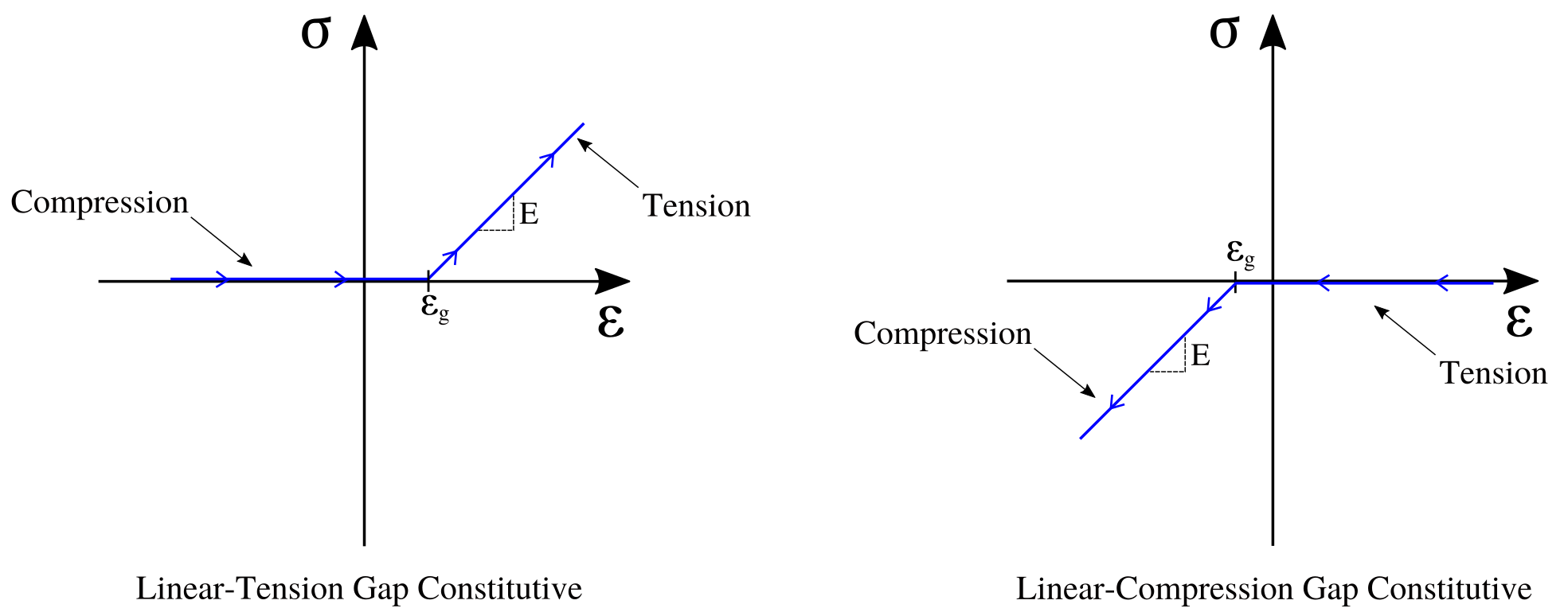The Elastic1DGap class creates a uniaxial material with the constitutive equation given as
\[ \sigma = \begin{cases} 0, & \epsilon \leq \epsilon_g \\ E(\epsilon - \epsilon_g), & \epsilon \geq \epsilon_g \end{cases} \]
where \(\sigma\) is the uniaxial stress, \(\epsilon\) is the uniaxial strain, \(E\) is the elasticity modulus, \(\epsilon_g\) is gap from which the material will take stress, and \(\epsilon_y\) is the yielding strain. The Figure shows the constitutive law of this material. No hysteresis behavior is present for this formulation.

REFERENCE:
The python Pre-Analysis in the 01-Pre_Process/Method/Attach.py file provides with an interface to populate the Entities dictionary. This file contains several functions to populate specific fields. For example, to create a Elastic1DGap material using json format, use:
addMaterial(tag, name='Elastic1DGap', attributes):
Example
A ELASTIC1DGAP can be defined using the python interface as follows:
SVL.addMaterial(tag=1, name='Elastic1DGap', attributes={'E': 50.0, 'gap': 0.2, 'behavior': 0})
Application
Please refer to the A16-DY_1D_Material_Fiber_Elastic_Gap.py file located at 03-Validations/01-Debugging/ to see an example on how to define a Elastic1DGap material.
On the contrary, the 01-Pre_Process/Method/Remove.py file provides with an interface to depopulate the Entities dictionary. For example, to remove an already define Material, use:
The C++ Run-Analysis in the 02-Run_Process/02-Materials/02-NonLinear/Elastic1DGap.cpp file provides the class implementation. A Elastic1DGap is created using the built-in json parse-structure provided in the Driver.hpp. A Elastic1DGap is defined inside the "Materials" json field indicating its "Tag" as follows,
{
"Materials": {
"Tag": {
"name" : "ELASTIC1DGAP",
"attributes": {
"E": double,
"gap": double,
"behavior": int
}
}
}
}
| Variable | Description |
|---|---|
Tag | Unique material object identifier. |
E | Represents the elasticity modulus. |
gap | Represents the gap (strain or separation) |
behavior | Represents if it is a tension (0) or compressive (1) gap. |
fy and gap.A uniaxial compressive ELASTIC1DGAP with elasticity modulus 50, and a gap of 0.2 is defined:
{ "Materials": { "1": { "name" : "ELASTIC1DGAP", "attributes": { "E" : 50.0, "gap" : 0.2, "behavior" : 1 } } } }